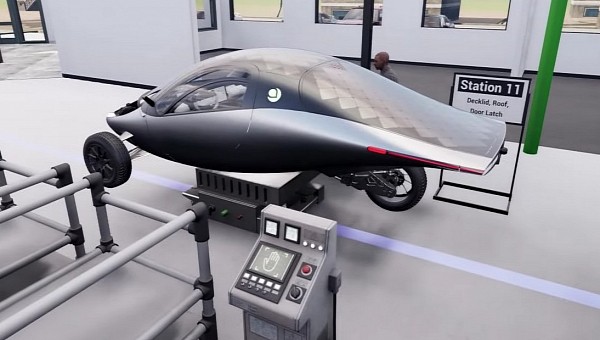Aptera said it is quickly approaching the Delta stage with its solar trike. That means it will get ready for production soon, but having a product ready for manufacturing also involves preparing the factory that will build this vehicle. The startup shared in a video all the way the trike will follow at the Carlsbad plant: it involves 13 stations.
If we got the video right, it is unfair to say there are only 13 steps in production. The animation starts with the presentation of the battery modules and the battery pack assembly, which should perhaps be the first station, but it is not treated like that. After the battery pack is ready, it goes to the belly pan mounting station. This station also deals with the rear suspension and brackets to the battery, whatever that means.
Right next to it is station 2, where the Aptera body-in-carbon (BINC) starts to resemble the trike as we know it. The front suspension is installed, and then the trike travels a fairly long way with the help of Red Viking’s automated guided vehicles (AGVs) to the third station, which is on the other side of the plant. There, the Aptera gets wiring harnesses, the HVAC system, and brakes.
Station 4 takes care of interior trim, while the fifth one installs terminal and HVAC components. At station 6, the Aptera gets high and low-voltage cables. The following one adds the coolant hoses to the trike's innovative cooling system: instead of having radiators, the EV uses its skin to cool the battery and other components.
Doors, decklid seals, and the windshield integrate the BINC at station 8, while station 9 gives the future Aptera its nose cone, wiper arm, hood seal, and cameras. At station 10, the solar trike receives the camera module and external panels, which is mostly the rear compartment lid at that point. Station 11 is the last one of this long straight line since station 4. The Aptera gets the decklid, roof, and door latches there.
When the AGV with the Aptera arrives at the next station, the trike gets its fluids. After that, the AGV puts the trike on the ground and gets back to start the whole process again, but the Aptera is not ready yet. A worker will move it to station 13 (probably driving it), where it gets the hood, the belly pan, and rear wheel covers. That also seems to be where the company makes sure everything is in the right place, with strong lights to perform a quality check.
The ready vehicles then form a line to be shipped to their owners. The factory will be able to produce 40 Apteras per day. With a second shift, it may be able to reach 80 units per day. If Aptera does not work on weekends, that means it will be able to make 1,600 trikes per month. The company already has 37,000 reservations for its solar trike. At full speed, the Carlsbad plant will take 1 year and 11 months to deliver all of them. That’s enough time for the company to get even more orders for what promises to be the most efficient vehicle in the world.
Right next to it is station 2, where the Aptera body-in-carbon (BINC) starts to resemble the trike as we know it. The front suspension is installed, and then the trike travels a fairly long way with the help of Red Viking’s automated guided vehicles (AGVs) to the third station, which is on the other side of the plant. There, the Aptera gets wiring harnesses, the HVAC system, and brakes.
Station 4 takes care of interior trim, while the fifth one installs terminal and HVAC components. At station 6, the Aptera gets high and low-voltage cables. The following one adds the coolant hoses to the trike's innovative cooling system: instead of having radiators, the EV uses its skin to cool the battery and other components.
Doors, decklid seals, and the windshield integrate the BINC at station 8, while station 9 gives the future Aptera its nose cone, wiper arm, hood seal, and cameras. At station 10, the solar trike receives the camera module and external panels, which is mostly the rear compartment lid at that point. Station 11 is the last one of this long straight line since station 4. The Aptera gets the decklid, roof, and door latches there.
When the AGV with the Aptera arrives at the next station, the trike gets its fluids. After that, the AGV puts the trike on the ground and gets back to start the whole process again, but the Aptera is not ready yet. A worker will move it to station 13 (probably driving it), where it gets the hood, the belly pan, and rear wheel covers. That also seems to be where the company makes sure everything is in the right place, with strong lights to perform a quality check.
The ready vehicles then form a line to be shipped to their owners. The factory will be able to produce 40 Apteras per day. With a second shift, it may be able to reach 80 units per day. If Aptera does not work on weekends, that means it will be able to make 1,600 trikes per month. The company already has 37,000 reservations for its solar trike. At full speed, the Carlsbad plant will take 1 year and 11 months to deliver all of them. That’s enough time for the company to get even more orders for what promises to be the most efficient vehicle in the world.




















